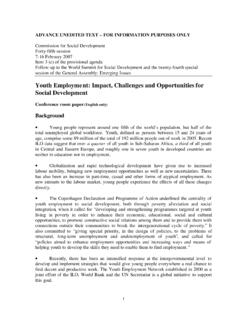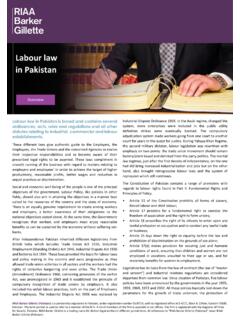Transcription of Youth employment and unemployment: an Indian …
1 A r u p M i t r a a n d S h e r V e r i c kM a r c h2 0 1 3D W T f o r S o u t h A s i a a n d C o u n t r y O f f i c e f o r I n d i aI L O A s i a-P a c i f i c W o r k i n g P a p e r S e r i e sY o u t h e m p l o y m e n t a n d u n e m p l o y m e n t : a nI n d i a n p e r s p e c t i v eDWT for South Asia and Country Office for IndiaILO Asia-Pacific Working Paper SeriesYouthemployment andunemployment:An IndianperspectiveArup Mitra and Sher VerickMarch 2013 ILO DWT for South Asia and Country Office for IndiaiiCopyright International labour 2013 First published 2013 Publications of theInternational labour Office enjoy copyright under Protocol 2 of the Universal CopyrightConvention. Nevertheless, short excerpts from them may be reproduced without authorization, on condition thatthe source is indicated.
2 For rights of reproduction or translation, application should be made to ILO Publications(Rights and Permissions), International labour Office, CH-1211 Geneva 22, Switzerland, or by The International labour Office welcomes such , institutions and other users registered with reproduction rights organizations may make copies inaccordance with the licences issued to them for this purpose. Visit to find the reproduction rightsorganization in your , Arup; Verick, SherYouth employment and unemployment : an Indian perspective/ ArupMitra and Sher Verick; InternationalLabour Organization, DWT for South Asia and Country Office for Delhi: ILO, 2013 ILO Asia-Pacific working paper series, ISSN2227-4491; 2227-4405 (web pdf)International labour Organization; ILO DWT for South Asia and ILO Country Office for Indiayouth employment / Youth unemployment / young worker / labour force participation / Cataloguing in Publication DataThe designations employed in ILO publications, which are in conformity with United Nations practice, and thepresentationof material therein do not imply the expression of any opinion whatsoever on the part of theInternational labour Office concerning the legal status of any country, area or territory or of its authorities, orconcerning the delimitation of its responsibility for opinions expressed in signed articles, studies and other contributions rests solely withtheir authors.
3 And publication does not constitute an endorsement by the International labour Office of theopinions expressed in to names of firms and commercial products and processes does not imply their endorsement by theInternational labour Office, and any failure to mention a particular firm, commercial product or process is not asign of publications and electronic products can be obtained through major booksellers or ILO local offices inmany countries, or direct from ILO Publications, International labour Office, CH-1211 Geneva 22,Switzerland, or ILODWT for South Asia and Country Office for India,Core 4B, 3rdFloor, India Habitat Centre,Lodhi Road, New Delhi 110003, India, or by Catalogues or lists of new publications areavailable free of charge from the above address, or by email: our inIndiaILO DWT for South Asia and Country Office for IndiaiiiPrefaceThe International labour Organization (ILO) is devoted to advancing opportunities for women andmen to obtain decent and productive work.
4 It aims to promote rights at work, encourage decentemployment opportunities, enhance social protection and strengthendialogue in handling work-related , decent work remainselusivein many countries, particularly asaconsequence of the globalfinancial crisis, which hashitlabour marketshard. As witnessed around the world, young people havesuffereddisproportionately since the onset of the crisis, which comes on top of the persistent barriersthey experience in gaining a foothold in the labour market. This situation represents one of thegreatest urgenciesfacingall paper by ArupMitra and Sher Verick provides important insights into the challenges facingyoung people in India in terms of underemployment, unemployment and the lack of job opportunitiesin the formal economy.
5 The study highlights the diversity in outcomes for young people depending ontheir educational attainment, social status and where they live. Overall, the findings underscore theneed for comprehensive approaches to promote more and better jobs for young people in India paper is part of the ILOAsia-Pacific Working Paper Series, whichaims toenhance the body ofknowledge, stimulate discussion and encourage knowledge-sharing and further research for thepromotion of decent work in Asia and the StaermoseDirector, ILO DWT for South Asia andCountry Office for IndiaILO DWT for South Asia and Country Office for IndiaivILO DWT for South Asia and Country Office for IndiavTable of are Youth participating in the labour marketin India?.. labour force participation of Youth in Youthworkerpopulation ratio (WPR).
6 Youth employment in The nature of Youth employment profile across unemploymentin analysis of determinants of Youth labour force of figures1. labour force participation rate (%) by age and location, Education and worker population ratio (WPR) (%), Youth unemployment rate (%) (usual status), unemployment rates (%)(usual status) by educational attainment, of tables1. labour force participation rate (%) of Youth and adults, labour forceparticipation rate (%) among Youth (15-29) by social categories, Age-specific worker population ratio (%) in rural areas, 1993-94, 1999-00, 2004-05,and Age-specific worker population ratio (%) in urban areas, 1993-94, 1999-00,2004-05, Youth worker population ratio (%) in rural and urban areas by educational attainment, Nature of employment (usual status), Sectoral employment shares (%), Youth unemployment rate (%) (usualand current dailystatus), unemployment rates (%) (usual status) in rural and urban areas by educational attainment, rates (%) (usual status) among Youth by social categories, Logisticregression.
7 Determinants oflabour force participation of Youth , DWT for South Asia and Country Office for IndiaviILO DWT for South Asia and Country Office for IndiaviiAcknowledgementsThis paper benefited from very helpful comments and inputs providedbyRuchika Chaudhary,Matthieu Cognac, Steffi Jochim, and Makiko Matsumoto, and participants in the ILO-Ministry ofLabour and employment forum, Decent Work for Youth in India , held on 20 April 2012 in would also like to thankChanitdaWiwatchanonand NeelamAgnihotrifor assistance withformatting and errors are the sole responsibility of the DWT for South Asia and Country Office for IndiaviiiILO DWT for South Asia and Country Office for IndiaixAbstractCreating jobs for young peopleis a major challenge around the world, which has been furtherexacerbated by the global financial crisis that hitthis grouphard.
8 In this broaderglobalcontext, thispaper presents a detailed profile of Youth employment and unemployment in India, which has theworld s largest Youth population . Young indians face major barriers because of poverty and lowlevels of human educational attainment has risen quickly in recent years, gaining afoothold in the labour market remains elusive for manyyoung indians . In rural and urban areas,young males are usually employed in casual jobs, while their female counterparts tend to be large proportion of youngruralwomen are employed in agriculture, ruralmales are increasinglyturning to the non-farm comparison,youngurbanmales are largelyworking in the services sector. Among young women, social conditions play an important role: labourforce participation, for example, is higher among scheduled castes, scheduled tribes and otherbackward castes,especiallyin rural areas.
9 In response to these challenges, policiesshouldaddress thelack of productive employment opportunities for Youth both in rural and urban skillsdevelopment is crucial, these initiatives should be supplemented by more comprehensive programmesthat target the most vulnerable and disadvantaged responsibility for opinions expressed in articles, studies and other contributionsrests solely with their authors, andpublication does not constitute an endorsement bythe International labour Office of the opinions expressed in them, or of any products,processes or geographical designations the authorsArup Mitra is Professor of Economics at the Institute for Economic Growth, Delhi Universityand SherVerick is Senior employment Specialist with the ILO Decent Work Technical SupportTeam for South Asia in New Delhi, DWT for South Asia and Country Office for IndiaxILO DWT for South Asia and Country Office for IndiaxiAbbreviationsILOI nternational labour OrganizationITII ndustrial Training InstitutionLFPRL abour force participation rateMGNREGSM ahatma Gandhi National Rural employment Guarantee SchemeWPRW orker population ratioILO DWT for South Asia and Country Office for IndiaxiiILO DWT forSouth Asia and Country Office for unemployment and underemployment is prevalent aroundthe world because young people lackskills, work experience, job search abilities and the financial resources to find employment (UnitedNations, 2003; ILO, 2006; Matsumoto et al.)
10 , 2012).In developing countries, this situation isexacerbated by poverty and the competitive pressures that result from a rapidly growing labour , the inadequacy of social protection schemes and active labour market policies means thatyoung people in such economies have little support outside their family and friends. Globally, youngpeople are, therefore, more likely to be unemployed or employed on more precarious contracts or inthe informal is the case even during good economic times. In the midst of a severe recession, Youth find itincreasinglydifficult to both acquire a job as a new entrant in the labour market, particularly as aconsequence of hiring freezes, and remain employed,since they are more likely to be laid off thanworkers with more seniority ( last in-first out ) (Verick, 2009).


















